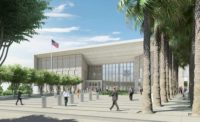The State Dept.’s embassy construction program has moved more slowly than officials had projected in 2005, completing far fewer major facilities than it had aimed to build by now, because smaller projects unexpectedly were added to its to-do list and inflation increased construction costs, the U.S. Government Accountability Office says in a newly issued report.
In the congressionally requested report, released on Oct. 25, GAO recommends steps to address the problems, and the State Dept. says it will adopt those recommendations.
GAO says that the projects added to the work plan of State’s Bureau of Overseas Buildings Operations (OBO) included embassy office annexes and housing for U.S. Marine Corps security guards on embassy complexes.
In the report, GAO also says that State has received only one inflation-related funding allocation since 1999 for the embassy program, and the higher inflation-related costs have hampered the program’s progress.
In the wake of terrorist bombings in 1998 at embassies in Kenya and Tanzania that killed more than 220 people, Congress passed legislation directing OBO to compile a list of embassies that should be replaced.
OBO’s list totaled 180 embassies; it later reduced that to about 170, by deciding to upgrade, not replace, some facilities.
In 2005, OBO had 30 projects in the works and said it planned to finish the other 140 by 2018, according to GAO.
But by the end of fiscal year 2017, OBO had completed only 77 embassy or consulate projects, and had another 21 under construction, by GAO's count. The total cost of the completed projects was slightly more than $24 billion.
[OBO, counting projects beyond embassies and consulates, such as annexes and Marine housing, says that from 1999 through October 2018, it has completed 149 projects, with 53 others in design or under construction.]
GAO says that most of the finished projects ended up costing more than originally estimated, and took longer to complete than planned, but adds that the increases in time and cost “were generally within budgeting and planning allowances.”
OBO officials also told GAO staffers that the bureau’s workload exceeds what its personnel can handle. OBO officials said that, as of April 2018, about 20% of the bureau’s authorized 1,415 positions were vacant, because of attrition and a State Dept. hiring freeze that extended from January 2017 to about May 2018.
GAO said that OBO faced personnel and workload “challenges,” but said the bureau wasn’t able to quantify them or the impact of the personnel shortage because OBO lacks an organization-wide “strategic workforce assessment” of its staffing.
GAO made four recommendations. They include estimating the impact of inflation on the construction program’s capacity and schedule, with periodic updates; and identifying embassies still to be completed, with estimated costs and schedules to carry out the work.
GAO also called for OBO to produce an analysis of the embassy program staffing level and workloads.
Reflecting comments from some contractors that “OBO was a difficult business partner,” GAO also said the bureau should launch a pilot “partnering” initiative for construction companies doing embassy projects, particularly involving firms that are new to the program.
OBO comments
In formal comments appended to GAO’s report, State said it concurred with all of GAO’s recommendations and would take steps to carry them out.
In an Oct. 31 emailed response to questions from ENR, the State Dept. said: “OBO is actively responding to each recommendation and intends to work proactively with GAO to develop and institute enduring systems that will drive the scope, delivery and cost of embassy projects to maximize use of taxpayer dollars while providing safe and secure facilities that support our diplomats around the globe.”
The department also said that it has a new director, Addison (Tad) Davis, who assumed his new post on Sept. 17. Davis, who had a 26-year career on active duty as an Army officer, joins OBO from the Defense Dept., where he was principal deputy assistant secretary for energy, installations and the environment.
In its comments to ENR, State said that OBO “is addressing issues identified in the report, to include staffing shortages, assessing the effects of inflation and foreign currency exchange on the cost of embassy projects, and piloting construction industry partnering—a best practice—to promote greater collaboration.”
Different approaches
Over the past couple of decades, OBO has used different approaches to embassy project delivery. In the mid-2000s, it used a standard embassy design and design-build contracting and cut project completion to about three years, almost half of a previous timetable.
But then, GAO recounts, OBO faced criticism that the standard designs were too “fortress-like,” and didn’t adapt to varying conditions around the world.
In 2010, OBO later turned to a new effort, initially called Design Excellence [see 2011 ENR story here], using individualized designs, which later was broadened beyond design and renamed Excellence in Diplomatic Facilities.
But critics then worried that the "Excellence" approach led to construction costs that were too high. [See January 2017 ENR story here.]
Now, in its comments added to the GAO report, OBO indicates that it has shifted to a new approach, saying that discussions of Excellence “should be framed as past tense.”
OBO adds that it has “taken the lessons learned” from methods including standard design and Excellence “to focus on several new initiatives that aim to lower project and long-term facility operations and maintenance costs.”
New contracts awarded
Separately, OBO on Oct. 29 announced the award of two new embassy construction contracts. B.L. Harbert International, Birmingham, Ala., won both—a $563-million contract for a new embassy in New Delhi and a $244-million contract for a new embassy in Tegucigalpa, Honduras.
One day later, OBO announced that Harbert had won contracts to construct U.S. consulate buildings in Hermosillo and Guadalajara, Mexico.
The department on Oct. 29 also announced the selection of design architects for two other projects: Skidmore, Owings & Merrill, San Francisco, for a new embassy complex in Windhoek, Namibia, and Miller Hull Partnership, Seattle, for a consulate in Merida, Mexico.
The Windhoek project’s total budget is $304 million; the Merida budget is $225 million.
And on Oct. 30, OBO said it had selected Ennead Architects, New York City, as design architect for a consular building in Chiang Mai, Thailand, and Miller Hull Partnership as design architect for a consular building in Casablanca, Morocco.
Story updated on 11/2/2018 with information on new director of Bureau of Overseas Buildings Operations




Post a comment to this article
Report Abusive Comment